ANGLE OF ELEVATION AND DEPRESSION EXAMPLES
Subscribe to our ▶️ YouTube channel 🔴 for the latest videos, updates, and tips.
Example 1 :
A student sitting in a classroom sees a picture on the black board at a height of 1.5 m from the horizontal level of sight. The angle of elevation of the picture is 30°. As the picture is not clear to him, he moves straight towards the black board and sees the picture at an angle of elevation of 45°. Find the distance moved by the student.
Solution :
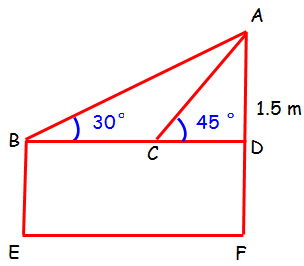
Distance moved by the student = BC
In triangle ABD :
∠ABD = 30°
tan θ = opposite side/Adjacent side
tan 30° = AD/BD
1/√3 = 1.5/BD
BD = 1.5 x √3 ==> 1.5 √3
In triangle ACD :
∠ACD = 45°
tan θ = opposite side/Adjacent side
tan 45° = AD/CD
1 = 1.5/CD
CD = 1.5
BC = BD - CD
BC = 1.5 √3 - 1.5
= 1.5 (√3 - 1) = 1.5(1.732 - 1)
= 1.5 (0.732) ==> 1.098 m
Hence the distance moved by the student is 1.098 m.
Example 2 :
A boy is standing at some distance from a 30 m tall building and his eye level from the ground is 1.5 m. The angle of elevation from his eyes to the top of the building increases from 30° to 60° as he walks towards the building. Find the distance he walked towards the building.
Solution :
From the given information, we can draw a rough diagram
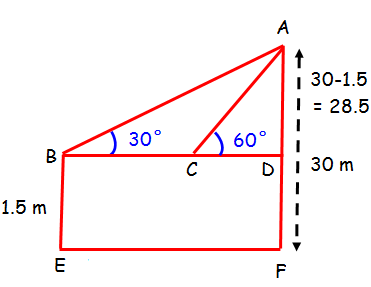
AD = 28.5 m
In triangle ABD
∠ABD = 30°
tan θ = opposite side/Adjacent side
tan 30° = AD/BD
1/√3 = 28.5/BD ==> BD = 28.5 √3 --(1)
In triangle ACD
∠ABD = 60°
tan θ = opposite side/Adjacent side
tan 60° = AD/CD
√3 = 28.5/CD ==> CD = 28.5/√3
Multiplying by √3 on both numerator and denominator, we get
CD = 28.5/√3 ==> 28.5√3/3 ==> 9.5√3 -->(2)
the distance he walked towards the building = BD - CD
= 28.5 √3 - 9.5√3 ==> 19√3 m
Example 3 :
From the top of a lighthouse of height 200 feet, the lighthouse keeper observes a Yacht and a Barge along the same line of sight .The angles of depression for the Yacht and the Barge are 45° and 30° respectively. For safety purposes the two sea vessels should be at least 300 feet apart. If they are less than 300 feet , the keeper has to sound the alarm. Does the keeper have to sound the alarm ?
Solution :
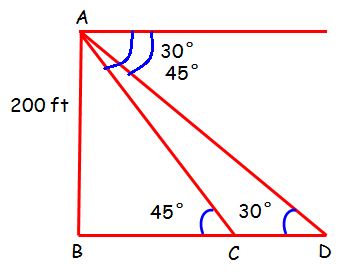
From the above picture, we have to find the value of CD.
In triangle ABC
∠ACB = 45°
sin θ = opposite side/Hypotenuse side
sin 45° = AB/BC
1/√2 = 200/BC
BC = 200 √2
In triangle ABD
∠ADB = 30°
sin 30° = AB /BD
1/2 = 200/BD
BD = 200 x 2 ==> 400
CD = BD - BC ==> 400 - 200 √2 ==> 200(2 - √2)
= 200 (2 - 1.414)
= 200(0.586) ==> 117.2 m
From this, we come to know that the distance between Yacht and a Barge is less than 300 m. Hence the keeper has to sound the alarm.
Example 4 :
A surveyor is standing 50 feet from the base of a large tree. The surveyor measures the angle of elevation to the top of the tree as 71.5°. How tall is the tree?
Solution :
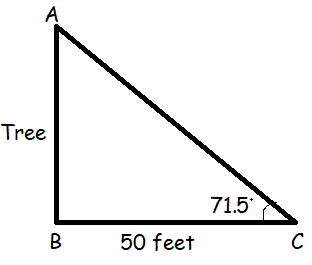
AB = opposite side, BC = adjacent side and AC = Hypotenuse
tan θ = Opposite side/Adjacent side
tan 71.5 = AB/BC
tan 71.5 = AB/50
AB = 50 tan 71.5
= 50(2.98)
AB = 149 ft
So, the height of the tree is 149 ft.
Example 5 :
At a point 200 feet from the base of a building, the angle of elevation to the bottom of a smokestack on the roof of the building is 35°, and the angle of elevation to the top of the smokestack is 53°. Find the height of the smokestack.
Solution :
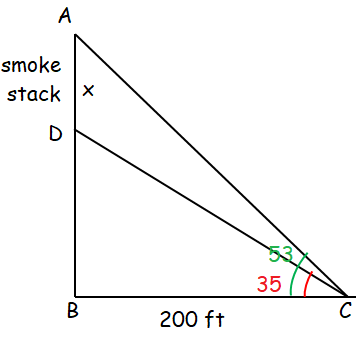
In triangle DBC,
tan θ = Opposite side/Adjacent side
tan 35 = DB/BC
tan 35 = DB/200
DB = 200(tan 35)
= 200 (0.700)
DB = 140
In triangle ABC,
tan 53 = (AD + DB)/BC
tan 53 = (140 + x)/200
140 + x = 200(tan 53)
140 + x = 200 (1.327)
140 + x = 265.4
x = 265.4 - 140
x = 125.4 ft
So, height of the smokestack is 125.4 ft.
Example 6 :
A kite is floating above a straight road. To estimate its height above the ground, the kite flyers simultaneously measure the angle of depression to two consecutive mileposts (meaning each post is a mile apart) on the road on the same side of the kite. The angles of depression are found to be 15° and 31°. How high is the kite?
Solution :
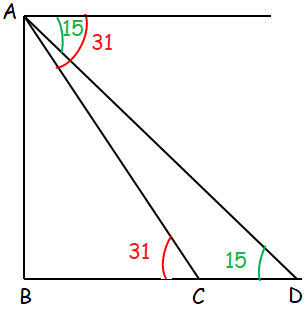
Opposite side = AB, BC and BD = adjacent sides and
AD = hypotenuse
In triangle ADB,
tan θ = Opposite side/Adjacent side
tan 15 = AB/BD
0.2679 = AB/BD
0.2679 = AB/(BC + CD)
AB = 0.2679(BC + CD) ------(1)
tan 31 = AB/BC
0.600 = AB/BC
AB = 0.6(BC) ------(2)
(1) = (2)
0.2679(BC + CD) = 0.6(BC)
CD = 1 (consecutive miles)
0.2679 BC - 0.6BC = -0.2679 CD
0.3321 BC = 0.2679
BC = 0.2679/0.3321
BC = 0.806 miles
1 mile = 5280 ft
0.806 miles = 0.806(5280)
= 4255.68 ft
Applying the value of BC,
AB = 0.6(0.806)
= 0.483 miles
0.483 miles = 0.483 (5280)
= 2550.24 ft
Subscribe to our ▶️ YouTube channel 🔴 for the latest videos, updates, and tips.
Kindly mail your feedback to v4formath@gmail.com
We always appreciate your feedback.
About Us | Contact Us | Privacy Policy
©All rights reserved. onlinemath4all.com
Recent Articles
-
Quantitative Reasoning Questions and Answers
Dec 14, 25 06:42 AM
Quantitative Reasoning Questions and Answers -
Specifying Units of Measure
Dec 14, 25 06:38 AM
Specifying Units of Measure -
Coin Tossing Probability
Dec 13, 25 10:11 AM
Coin Tossing Probability - Concept - Sample Space - Formula - Solved Problems